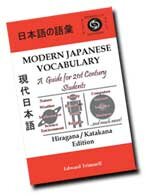
Departments
Intermediate Japanese - Free Online Course

Some Things You’ll Need to Teach Yourself Japanese
If you have access to formal Japanese classes, I would certainly recommend taking advantage of these. However, you may lack the time, resources, etc. for a formal college course in the language. Since many people learn Japanese for professional reasons, it therefore follows that many students of Nihongo are too busy for anything but the self-study route.
Self-directed learners of the Japanese language often don’t know where to start. There are a myriad of materials on the market that can help you to learn Japanese, but no one can buy them all. So how do you narrow down your choices?
Below is a brief introduction to some of the tools that are useful for beginning students. Although I recommend a handful of specific items, our focus will be on the categories of learning materials that are necessary.
Progressive Textbook
A progressive textbook is arranged in lessons that build on each other. It starts with easy material, then works up to more difficult topics. Many of the progressive textbooks come with audio materials.
For Japanese, I would recommend the Ultimate Japanese Basic-Intermediate course from Living Language, and the Japanese for Busy People series. These courses are moderately priced and fairly easy to get your hands on.
Systematically follow the course outlined in the book so that there are no gaps in your knowledge. Resist the temptation to skip around too much. To pace yourself, devise your own “syllabus” that outlines the number of chapters you will complete each month. Stick to the goals you set for yourself.
Kanji Text
Learning the kanji is one of the most challenging aspects of mastering Japanese. As you learn kanji, you will recognize some patterns that will make the going easier, but mostly it is a matter of rote memorization.
The secret is to absorb a few new kanji each day. Break up the task into manageable portions so that you don’t become overwhelmed. But don’t be tempted to delay your kanji studies, either. Although you can learn Japanese grammar and vocabulary using romaji (transliterated) texts, you will never be truly competent in Japanese until you learn the kanji. So just do it!
Kanji & Kana by Wolfgang Hadamitzky & Mark Spahn is the most widely used kanji text on the market. I used it when I started learning Japanese back in the 1980s, and new students are still using it today. The layout of the book facilitates the looking up of specific kanji, as well as general kanji study. Pronunciation guides are given in romaji.
I also like The Kodansha Kanji Learner's Dictionary and Nelson’s Japanese-English Character Dictionary . These are more advanced, thicker tomes that are useful additions to your bookshelf. But if you can only buy one kanji book, I would recommend going with Kanji & Kana.
Grammar Reference Text
This is a book dedicated solely to Japanese grammar. It will enable you to take a deeper dive into the grammatical topics that are covered in your progressive textbook. A Dictionary of Basic Japanese Grammar by Makino and Tsutsui is my favorite in this category. The book’s alphabetical layout of topics and abundant example sentences make it very easy to use. I also recommend Yoko McClain’s Handbook of Modern Japanese Grammar. This is an older text, and you may have difficulty finding it. But if you can locate one on Ebay, it will be well worth your money and effort.
Dictionary
You will need a Japanese-English dictionary, as well as an English-Japanese dictionary. Alternatively, you can buy a single dictionary that contains both.
At the beginner stage, it is a good idea to buy a small pocket dictionary that you can use to look up high-frequency words, as well as a larger dictionary for looking up the Japanese translation for sophisticated vocabulary like “leveraged buyout” or “currency speculation.”
In addition to a dictionary, consider a thematically arranged vocabulary guide. Modern Japanese Vocabulary: A Guide for 21st Students was created to be the most thorough vocabulary guide on the market. (Page views available online.)
Other Tools...
Pimsleur
Some people swear by the Pimsleur CDs, others consider them to be extremely overpriced for the small amount of language that they actually teach you. I come down somewhere in the middle. The Pimsleur CDs are a supplement, not a main course. They are most useful when you are in the early stages of learning a language that has a tricky phonetic system. If you have some extra cash and a long daily commute, you might consider Pimsleur’s Japanese CDs. But don’t take out a second mortgage on your home to buy a set.
Vocabulearn
Vocabulearn CDs are short audio flashcards. Like the Pimsleur CDs, they are formatted so that you can benefit from them without referring to any written materials. They are reasonably priced and very helpful for the mass acquisition of vocabulary.
The Internet
Finally, there are many sites on the Internet that can help you learn Japanese. In addition to this one, I would also recommend TheJapanesePage.com, and About.com’s site for Japanese language studies.
